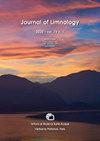科卡水电站大坝对埃塞俄比亚阿瓦什河流域大型无脊椎动物群的影响
IF 1.1
4区 环境科学与生态学
Q4 LIMNOLOGY
引用次数: 0
摘要
科卡水电站大坝是埃塞俄比亚最古老的大坝之一。筑坝是影响水生生物分布的人为活动之一。然而,迄今为止,人们很少关注大坝对埃塞俄比亚河流大型无脊椎动物群落的影响。因此,本研究的目的是评估科卡水电站大坝对埃塞俄比亚阿瓦什河流域大型无脊椎动物群落的影响。在阿瓦什河的三个河段(上游靠近河源、中游在大坝上方、下游在大坝下方),共选择了 15 个地点进行取样。统计分析检验了三个河段之间大型无脊椎动物组合模式或一系列单变量指标没有差异的零假设。其他分析包括确定造成大型无脊椎动物结构显著差异的类群(如相似度百分比),以及探索大型无脊椎动物结构的变量(如典型对应分析)。在阿瓦什河的上游、中游和下游,我们共记录到 73 个分类群,隶属于 43 科 12 目。鞘翅目是上游河段的优势目,而双翅目则是中游和下游河段的优势目。大型无脊椎动物的多样性从上游向中下游递减。三条河流在香农(Shannon)和辛普森(Simpson)多样性指数、EPT%、EPT类群丰度、总类群丰富度、均匀度指数、采集者%和刮食者%等方面存在显著差异。在这项研究中,我们观察到大型无脊椎动物的组合差异和空间模式与河流流量变化(流速)、磷酸盐浓度和底质指数的值有显著关联。本研究的结果对今后评估大坝建设对所研究地区河流的影响具有广泛的意义。本文章由计算机程序翻译,如有差异,请以英文原文为准。
Impacts of the Koka hydropower dam on macroinvertebrate assemblages in the Awash River Basin in Ethiopia
The Koka hydropower dam is one of the oldest large dams in Ethiopia. Damming is one of the anthropogenic activities impacting the distribution of aquatic life forms. However, to date, little attention has been focused on the dam’s impacts on the river macroinvertebrate assemblages in Ethiopia. The objective of this study was, therefore, to assess the impacts of the Koka hydropower dam on macroinvertebrate assemblages in the Awash River basin in Ethiopia. In the three river reaches on the Awash River (upstream near the source of the river, midstream above the dam, and downstream below the dam), a total of 15 sites were selected for sampling. The statistical analysis tested the null hypothesis that there are no differences in macroinvertebrate assemblage patterns or a range of univariate metrics between the three river reaches. Additional analyses involved the identification of taxa responsible for significant differences in macroinvertebrate structure (e.g., percentage similarity) and an exploration of the variables that structure macroinvertebrates (e.g., canonical correspondence analysis). In the upstream, midstream, and downstream reaches of the Awash River, we recorded a total of 73 taxa belonging to 43 families and 12 orders. Trichoptera was the dominant order in the upstream river reach, whereas Diptera dominated the midstream and downstream river reaches. The diversity of macroinvertebrates decreased from upstream to midstream and downstream. The three river reaches differed significantly in Shannon and Simpson diversity indices, % EPT, EPT taxa abundance, total taxa richness, evenness index, % collectors, and % scrapers. In this study, we observed that macroinvertebrate assemblage differences and spatial patterns were significantly associated with values of river flow changes (velocity), phosphate concentration, and substrate index. The findings of this study have broad implications for the assessment of the impacts of dam construction on the rivers of the studied region in the future.
求助全文
通过发布文献求助,成功后即可免费获取论文全文。
去求助
来源期刊

Journal of Limnology
地学-湖沼学
CiteScore
2.70
自引率
6.20%
发文量
12
审稿时长
3 months
期刊介绍:
The Journal of Limnology publishes peer-reviewed original papers, review papers and notes about all aspects of limnology. The scope of the Journal of Limnology comprises the ecology, biology, microbiology, physics, and chemistry of freshwaters, including the impact of human activities, management and conservation. Coverage includes molecular-, organism-, community-, and ecosystem-level studies on both applied and theoretical issues. Proceedings of workshops, specialized symposia, conferences, may also be accepted for publication.
 求助内容:
求助内容: 应助结果提醒方式:
应助结果提醒方式:


